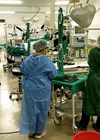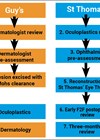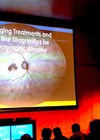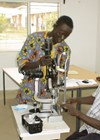Ophthalmology
The work of BIPOSA
The British and Irish Paediatric Ophthalmology and Strabismus Association (BIPOSA) was set up in 2008 to merge two streams of ophthalmology, namely the practice of paediatric ophthalmology and the practice of strabismus (to include refracting in children, and strabismus in...
The work of RNIB and ECLOs
With more than 2,000,000 people in the UK living with some degree of sight loss and over 300,000 registered as blind or partially sighted, it is important for anyone living with sight loss to know they’re not alone. At what...
Observership in Dar es Salaam
In this report, both authors present their personal experiences of an observership at the Comprehensive Community Based Rehabilitation in Tanzania (CCBRT) Hospital, a large regional teaching hospital located in Dar es Salaam, with a particular focus on resource management, attitudes...
A novel integrated practice unit (IPU) approach to periocular skin cancer management
The COVID-19 pandemic was one of the biggest challenges to face NHS workers. However, history has repeatedly shown that times of difficulty can result in the development of significant social and technological advances. We describe our own experience of this...
Update on emerging therapies for age-related macular degeneration
The 23rd European Society of Retina Specialists (EURETINA) Congress, held in Amsterdam, the Netherlands, provided a timely update on anti-complement therapy for geographic atrophy and emerging investigational therapies for neovascular age-related macular degeneration. Anti-complement therapy for geographic atrophy Geographic atrophy...
My top five: A foundation doctor’s top five misconceptions about ophthalmology
Choosing a specialty is challenging. As a foundation doctor, it often feels as if this choice is based solely on fleeting experiences. Compared to other specialties, there is relatively little exposure to ophthalmology during either medical school or foundation years....
From novice to overnight on-calls: developing an ophthalmology bootcamp to ease the learning curve for new trainees
Introduction My first ophthalmology on-call was nine years ago and it was a fairly traumatic experience. I was an FY2 in a Welsh district general hospital and I was on my own – at least, that’s how it felt to...
Glaucoma: 30 years on
Back in 1993, the late and great Barry Cullen FRCS (Cavan born, Dublin trained), the first editor of Eye News, asked me to write an article about the current treatment of chronic open angle glaucoma (COAG). At the time I...
Understanding the inequalities of ophthalmic care for Indigenous people in a first world country
Aboriginal Australians have faced numerous challenges over the past centuries. Here in this article, Edward Saxton highlights why there are inequalities of ophthalmic care in Australia and why this has led to increased levels of blindness in Aboriginal people relative...
My top five: Influential ophthalmologists
Ophthalmology has witnessed remarkable evolution and advancements throughout history. The field has undergone dramatic change and development since the times of Ancient Egypt where the first reference to eyes was made in the Code of Hammurabi (2250 BC) [1]. From...
How do you solve the problem of trachoma in Ethiopia?
Background Trachoma is one of the oldest diseases known to humankind and the leading infectious cause of blindness worldwide. Spread by the bacterium chlamydia trachomatis, it is transmitted through contact with the eyes, eyelids and nose of those infected. The...
Impact of Eye Health Surveys and Partnerships in The Gambia
This article brings together the three national eye health surveys that have been undertaken in The Gambia between 1986 and 2019 and the impact that the results have had nationally and internationally. In it we describe the long-term capacity-strengthening for...
















